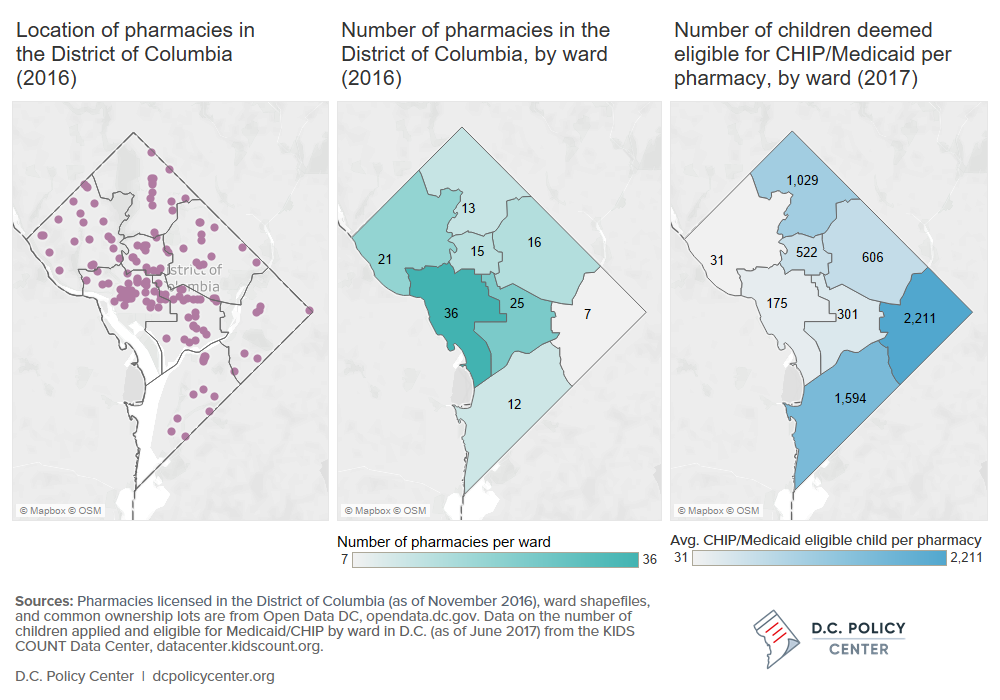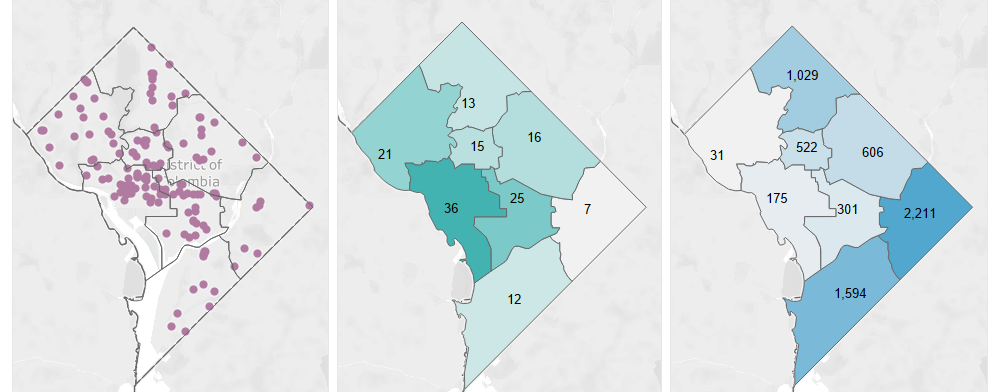The D.C. Council spent a significant amount of time discussing health access, especially access to hospitals, during budget deliberations this past month. We wondered: how does access to pharmacies—one of the simplest and most basic form of health care—vary across the city?
Pharmacies are an important link between hospitals, doctors, and patients. Pharmacies can expand the reach of preventative services in communities with less access to other providers, improving both individual health outcomes and the public health of communities—for example, by advertising the availability of vaccines, or the need to check blood pressure. Variation in access to pharmacies across the city are also connected to broader, ongoing discussions about health equity and economic opportunities in the District, and the building blocks of D.C.’s formal and informal health care infrastructure. Pharmacies are a particularly notable part of the health landscape for children with chronic conditions who need regular access to medications, such as asthma medication.
However, just as many economically and racially segregated neighborhoods have low access to primary care physicians, those same communities may also have fewer options for pharmacy services. Taking into account income and transportation access in addition to pharmacy locations, a 2012 Health Affairs article found that over one million Chicago residents live in “pharmacy deserts.” These pharmacy deserts were more common in segregated black and Hispanic neighborhoods, and this pattern that could contribute to disparities in the use of needed prescription medications. “People living in segregated minority—particularly segregated black—communities needed to travel farther to get to a pharmacy, compared to people in segregated white communities,” the authors wrote, adding that “the differences among community types were particularly pronounced for communities that were also low income.”
A brief examination of pharmacy license data from the D.C. Department of Health from 2016 suggests that D.C.’s residents also face stark disparities in access to pharmacies. That year, the city reported issuing 145 licenses to operating pharmacies. Pharmacies in the District of Columbia are heavily concentrated in D.C.’s downtown and daytime centers of population, with 36 licensed pharmacies in Ward 2 and 25 in Ward 6. Ward 3 has 21 pharmacies, while Ward 7 has only seven, and Ward 8 has 12.

Comparing this to the number of children who applied and were eligible for Medicaid and CHIP, a measurement that captures factors around both household income and health, show even stronger contrasts. The data shows that children in low-income households (measured here as those deemed eligible for Medicaid/CHIP), who are more likely to experience poor health and chronic health conditions, have the weakest access to pharmacy services. As the maps above show, Ward 3 has an average of 31 Medicaid/CHIP-eligible children per licensed pharmacy, compared with 2,211 eligible children per pharmacy in Ward 7, 1,594 in Ward 8, and 1,029 in Ward 4.1
This is not a full picture of health care access across D.C., or even a full picture of access to pharmacies—there may be additional gaps in what level of access to medicine and services residents may have at pharmacies in different locations. But it demonstrates that even this part of the health care ecosystem is weaker in parts of the city with the greatest need, connected to ongoing inequities in health care infrastructure, economic opportunity, and the commercial entities—including pharmacies, but also grocery stores, gyms, and restaurants—that contribute to both individual and public health outcomes.
About the data
Data on the number of pharmacies in D.C. and by ward are from DC Open Data, Pharmacy Locations. This data includes the location of pharmacies licensed in the District of Columbia as of November 4, 2016. This dataset was created as part of the DC Geographic Information System (DC GIS) for the D.C. Office of the Chief Technology Officer (OCTO) and the D.C. Department of Health. The data’s original source was a database provided by the D.C. Department of Health (Health Regulation and Licensing Administration, Pharmacy Control Division), which identified pharmacy locations.
Data on the number of children eligible for CHIP/Medicaid per pharmacy by ward as of June 2017 are from the Annie E. Casey Foundation’s KIDS COUNT Data Center. This data set, Children applied and eligible for Medicaid/CHIP by ward in District of Columbia, shows the number of children and youth under age 18 in families who applied and were deemed eligible for Medicaid/CHIP in June of 2017. The data’s original source was the D.C. Department of Health Care Finance’s Division of Analytics and Policy Research.
